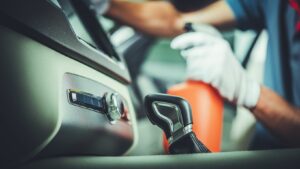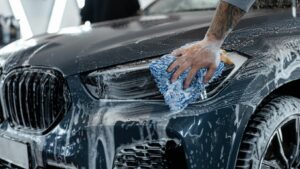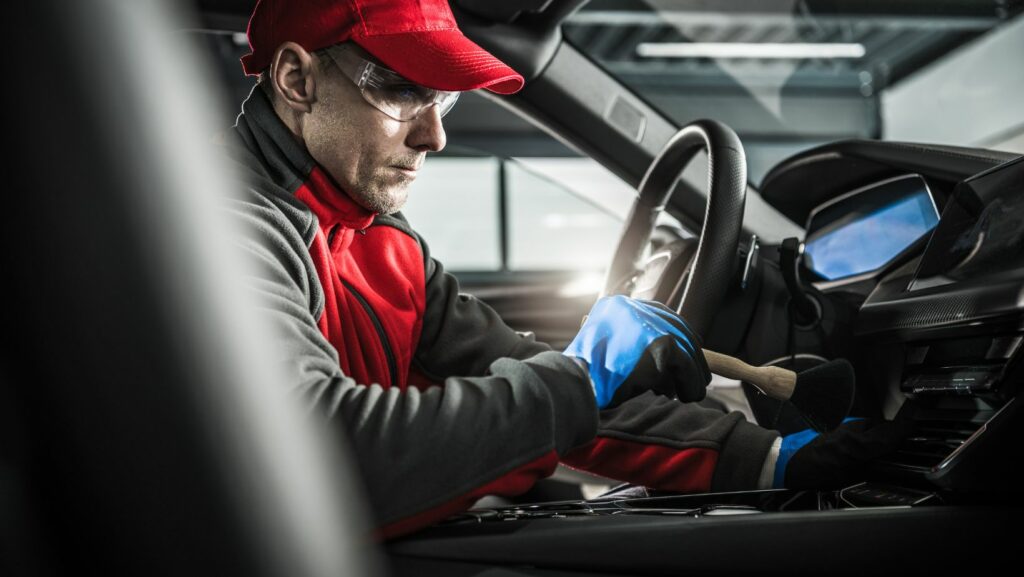Wet Paint Automotive Car Detailing, Ceramic Coating, and PPF
- Wet Paint Detailing: Enhances a vehicle’s aesthetics while providing essential protection against contaminants and UV rays, ultimately retaining higher resale value.
- Ceramic Coating Benefits: Offers long-lasting protection (2-5 years) against scratches, chemical stains, and UV degradation, while enhancing the vehicle’s gloss and hydrophobic properties for easier maintenance.
- Importance of PPF: Protects vehicles from physical damage due to road debris and harsh conditions, featuring self-healing properties and resistance to yellowing.
- Complementary Techniques: Each method—wet paint detailing, ceramic coating, and PPF—serves distinct roles, combining immediate visual enhancement with long-term protection.
- Installation Process: Both ceramic coating and PPF require thorough preparation and skilled application to ensure durability and effectiveness in protecting vehicle surfaces.
In the world of automotive care, maintaining a car’s pristine appearance goes beyond the occasional wash. Wet paint automotive car detailing has emerged as a game changer, offering a meticulous approach to rejuvenating vehicles. This technique not only enhances the car’s aesthetic but also protects its surface from the elements.
Ceramic coating and paint protection film (PPF) are vital components of this detailing process. They provide an extra layer of defense against scratches, UV rays, and contaminants. With the right application, these treatments can keep a vehicle looking showroom-fresh for years. Understanding the benefits and techniques of wet paint detailing, ceramic coatings, and PPF can transform any car enthusiast’s approach to vehicle maintenance.
Wet Paint Automotive Car Detailing
Wet paint automotive car detailing enhances a vehicle’s aesthetics while providing essential protection. This process involves various techniques designed to preserve the car’s surface and maintain its value.
Benefits of Wet Paint Detailing

- Enhanced Appearance: Wet paint detailing restores a vehicle’s gloss and shine, making it look freshly polished.
- Protection Against Contaminants: The detailing process removes contaminants such as dirt, bird droppings, and road grime that can damage the paint.
- Improved Resale Value: A well-maintained vehicle retains higher resale value, attracting more potential buyers.
- UV Protection: Detailing offers protection against UV rays, which can fade and damage the paint over time.
- Long-Lasting Results: Utilizing sealants and coatings during detailing extends the durability of the finish, providing ongoing protection.
- Washing: Using pH-balanced shampoos prevents paint damage while effectively removing dirt and debris.
- Claying: Clay bars eliminate stubborn contaminants bonded to the paint, ensuring a smooth finish.
- Polishing: Polishes remove surface imperfections like swirls and scratches, enhancing the overall shine.
- Sealing: Sealants create a protective barrier that shields the paint from environmental hazards.
- Ceramic Coating Application: Application of ceramic coatings provides long-term protection, making the surface more hydrophobic and resistant to stains.
Each technique plays a crucial role in ensuring that vehicles not only look their best but are also protected against the elements.
Ceramic Coating
Ceramic coatings offer advanced protection for vehicles, ensuring a durable shield against environmental elements. This technological innovation enhances the car’s aesthetics while providing significant advantages over traditional waxing.
Advantages of Ceramic Coatings
- Enhanced Protection: Ceramic coatings create a strong bond with the vehicle’s paint, offering superior protection against scratches, chemical stains, and contaminants.
- UV Ray Resistance: Ceramic coatings provide excellent UV protection, preventing paint oxidation and fading from sun exposure.
- Hydrophobic Properties: The coating creates a water-repellent surface that causes water to bead and roll off, minimizing dirt accumulation and simplifying washing.
- Long-lasting Durability: Once applied, ceramic coatings can last anywhere from two to five years, reducing the need for frequent reapplication compared to traditional wax.
- Improved Aesthetics: The application of ceramic coatings enhances the gloss and depth of the vehicle’s paint, contributing to a showroom finish.
- Surface Preparation: Thorough cleaning and polishing of the vehicle are essential to eliminate imperfections and contaminants.
- Decontamination: A clay bar treatment removes embedded dirt and impurities from the paint surface, ensuring a smooth finish.
- Surface Inspection: After decontamination, a detailed inspection checks the surface for any remaining flaws that require correction.
- Coating Application: The ceramic coating is applied in small sections using a specialized applicator. This step requires meticulous attention to ensure even coverage and proper bonding.
- Curing Time: After application, the coating requires a specific curing period to achieve optimal hardness and durability. This process can take several hours to complete.
- Final Inspection: A final inspection ensures that the coating has cured correctly and that the finish meets quality standards, providing a reflective and protective layer for the vehicle.
Paint Protection Film (PPF)
Paint protection film (PPF) is an essential component of automotive detailing, providing a robust barrier against environmental hazards. PPF protects a vehicle’s surface from scratches, chips, and other forms of damage, significantly enhancing car care.
Importance of PPF in Car Care
PPF serves multiple purposes in car maintenance. This transparent, durable film shields the paint from physical damage caused by road debris, rocks, and harsh weather conditions. PPF resists yellowing and degradation over time, ensuring the vehicle maintains its aesthetic appeal. Superior self-healing properties allow minor scratches and swirl marks to disappear under heat, keeping the surface pristine. Furthermore, PPF protects against UV rays, preventing paint oxidation and fading, which helps in preserving the car’s resale value.
Installation Process for PPF

The installation of PPF requires precision and expertise. Initially, the vehicle undergoes a thorough cleaning to remove dirt and contaminants from the surface. Next, professionals conduct a careful inspection to identify any imperfections that may need addressing. During installation, PPF is typically cut to fit specific areas, such as the hood, fenders, and bumpers, ensuring coverage of high-impact zones.
Once cut, the installer applies a special adhesive to the film and positions it accurately on the vehicle’s surface. Heat may be applied to activate the adhesive and facilitate bonding. After application, a final inspection checks for bubbles or imperfections, allowing for adjustments. The result is a smooth, protective layer that enhances the vehicle’s longevity and appearance.
Comparison of Wet Paint Detailing, Ceramic Coating, and PPF
Wet paint detailing, ceramic coating, and paint protection film (PPF) each serve distinct but complementary roles in vehicle maintenance.
Wet Paint Detailing
Wet paint detailing focuses on restoring and maintaining a vehicle’s appearance. It involves multiple stages, including washing, claying, polishing, sealing, and applying ceramic coatings. Each stage contributes to a vehicle’s aesthetic appeal and surface protection.
- Washing removes contaminants and dirt.
- Claying eliminates bonded contaminants for a smooth finish.
- Polishing targets and corrects paint imperfections, enhancing gloss.
- Sealing provides a temporary protective layer against environmental elements.
Wet paint detailing provides immediate aesthetic improvements and essential protection, maintaining the vehicle’s value.
Ceramic Coating
Ceramic coating offers long-lasting protection by forming a durable layer on the vehicle’s surface.
- Durability lasts between two to five years, outperforming traditional wax.
- Scratch resistance protects against minor abrasions.
- Chemical resistance shields the paint from stains and harmful substances.
- UV protection prevents paint oxidation and fading.
Hydrophobic properties ensure water beads and rolls off, keeping surfaces cleaner for longer. Maintenance becomes easier with reduced frequency of washing and polishing.
Paint Protection Film (PPF)
Paint protection film provides essential defensive measures against physical damage.
- Scratch protection guards against road debris and minor impacts.
- Self-healing properties allow minor scratches to disappear over time.
- Yellowing resistance maintains clarity and appearance under UV exposure.
PPF installation begins with thorough surface cleaning, followed by precise cutting and application, ensuring a snug fit on vulnerable areas. PPF provides a high level of protection without compromising the vehicle’s appearance.
| Feature | Wet Paint Detailing | Ceramic Coating | Paint Protection Film (PPF) |
|---|---|---|---|
| Immediate Aesthetic Boost | Yes | Limited | Limited |
| Long-Term Protection | No | Yes | Yes |
| Scratch Resistance | Moderate | High | Very High |
| Maintenance Ease | Moderate | High | High |
| Installation Complexity | Low | Moderate | High |
Understanding the differences among these techniques helps vehicle owners make informed decisions. Wet paint detailing offers immediate visual enhancement, ceramic coatings provide long-term protection, and PPF delivers robust defensive capabilities. Each method can enhance vehicle maintenance, ensuring it remains in optimal condition.
Essential for Any Vehicle
Investing in wet paint automotive car detailing along with ceramic coating and paint protection film is essential for any vehicle owner looking to preserve their car’s beauty and longevity. Each method plays a vital role in maintaining the vehicle’s surface while providing unique benefits.
With wet paint detailing, car owners can achieve an immediate visual enhancement and protection from contaminants. Ceramic coatings deliver long-lasting defense against environmental hazards while enhancing the paint’s appearance. PPF adds an extra layer of security against physical damage, ensuring the vehicle stays in pristine condition.
Together, these techniques create a comprehensive approach that not only boosts aesthetics but also safeguards the vehicle’s value over time.

